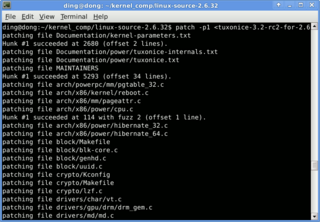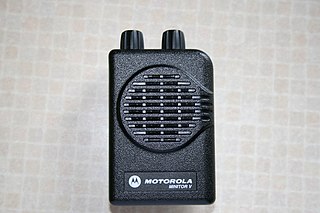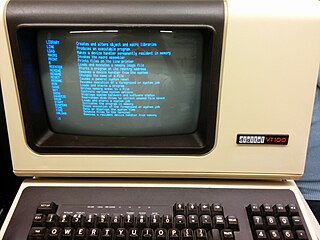uniq is a utility command on Unix, Plan 9, Inferno, and Unix-like operating systems which, when fed a text file or standard input, outputs the text with adjacent identical lines collapsed to one, unique line of text.

MSX is a standardized home computer architecture, announced by ASCII Corporation on June 16, 1983. It was initially conceived by Microsoft as a product for the Eastern sector, and jointly marketed by Kazuhiko Nishi, the director at ASCII Corporation. Microsoft and Nishi conceived the project as an attempt to create unified standards among various home computing system manufacturers of the period, in the same fashion as the VHS standard for home video tape machines. The first MSX computer sold to the public was a Mitsubishi ML-8000, released on October 21, 1983, thus marking its official release date.

In computing, ls is a command to list computer files and directories in Unix and Unix-like operating systems. It is specified by POSIX and the Single UNIX Specification.

A ringtone is the sound made by a telephone to indicate an incoming telephone call. Originally referring to the sound of electromechanical striking of bells or gongs, the term refers to any sound by any device alerting of an incoming call.
Call waiting is a telephone service where a subscriber can accept a second incoming telephone call by placing an in-progress call on hold—and may also switch between calls. With some providers it can be combined with additional features such as conferencing, call forwarding, and caller ID. Call waiting is intended to alleviate the need to have more than one telephone line or number for voice communications.

The computer tool patch is a Unix program that updates text files according to instructions contained in a separate file, called a patch file. The patch file is a text file that consists of a list of differences and is produced by running the related diff program with the original and updated file as arguments. Updating files with patch is often referred to as applying the patch or simply patching the files.

A PC speaker is a loudspeaker built into some IBM PC compatible computers. The first IBM Personal Computer, model 5150, employed a standard 2.25 inch magnetic driven (dynamic) speaker. More recent computers use a tiny moving-iron or piezo speaker instead. The speaker allows software and firmware to provide auditory feedback to a user, such as to report a hardware fault. A PC speaker generates waveforms using the programmable interval timer, an Intel 8253 or 8254 chip.

tr is a command in Unix, Plan 9, Inferno, and Unix-like operating systems. It is an abbreviation of translate or transliterate, indicating its operation of replacing or removing specific characters in its input data set.

wc is a command in Unix, Plan 9, Inferno, and Unix-like operating systems. The program reads either standard input or a list of computer files and generates one or more of the following statistics: newline count, word count, and byte count. If a list of files is provided, both individual file and total statistics follow.
An output device is any piece of computer hardware that converts information/DATA into a human-perceptible form or, historically, into a physical machine-readable form for use with other non-computerized equipment. It can be text, graphics, tactile, audio, or video. Examples include monitors, printers, speakers, headphones, projectors, GPS devices, optical mark readers, and braille readers.

In computing, more is a command to view the contents of a text file one screen at a time. It is available on Unix and Unix-like systems, DOS, Digital Research FlexOS, IBM/Toshiba 4690 OS, IBM OS/2, Microsoft Windows and ReactOS. Programs of this sort are called pagers. more is a very basic pager, originally allowing only forward navigation through a file, though newer implementations do allow for limited backward movement.
tail is a program available on Unix, Unix-like systems, FreeDOS and MSX-DOS used to display the tail end of a text file or piped data.
The dump command is a program on Unix and Unix-like operating systems used to back up file systems. It operates on blocks, below filesystem abstractions such as files and directories. Dump can back up a file system to a tape or another disk. It is often used across a network by piping its output through bzip2 then SSH.
In computing, sleep is a command in Unix, Unix-like and other operating systems that suspends program execution for a specified time.
The reorder tone, also known as the fast busy tone, or the congestion tone, or all trunks busy (ATB) tone is an audible call progress tone in the public switched telephone network (PSTN) that is returned to a calling party to indicate that the call cannot be processed through the network.
MSX-DOS is a discontinued disk operating system developed by Microsoft for the 8-bit home computer standard MSX, and is a cross between MS-DOS v1.25 and CP/M-80 v2.2.

The Motorola Minitor is a portable, analog, receive only, voice pager typically carried by fire, rescue, and EMS personnel to alert of emergencies. The Minitor, slightly smaller than a pack of cigarettes, is carried on a person and usually left in selective call mode. When the unit is activated, the pager sounds a tone alert, followed by an announcement from a dispatcher alerting the user of a situation. After activation, the pager remains in monitor mode much like a scanner, and monitors transmissions on that channel until the unit is reset back into selective call mode either manually, or automatically after a set period of time, depending on programming.

SISNE plus is a DOS 3.3 compatible clone created by Itautec and Scopus Tecnologia in Brazil prior to the end of the Market Reserve in 1991, which, at that time, forbade the importation of electronic equipment and software for general use. The system was sold with PC/XT compatible Itautec IS 30 computers and with Itautec IS 386 computers. With the widespread use of MS-DOS after the importations were allowed, the SISNE plus operating system was discontinued.
Music Macro Language (MML) is a music description language used in sequencing music on computer and video game systems.

In computing, the print command provides single-user print spooling capability in a number of operating systems. It is roughly similar to that provided by the UNIX System V lp and BSD lpr print spooler systems.











